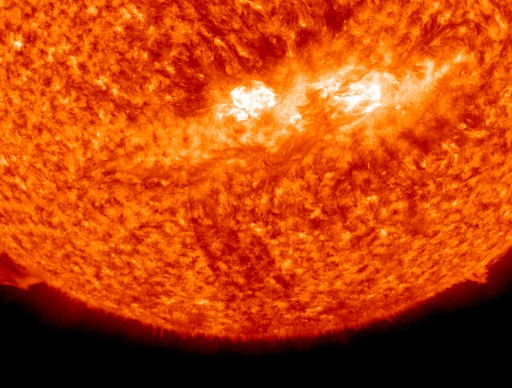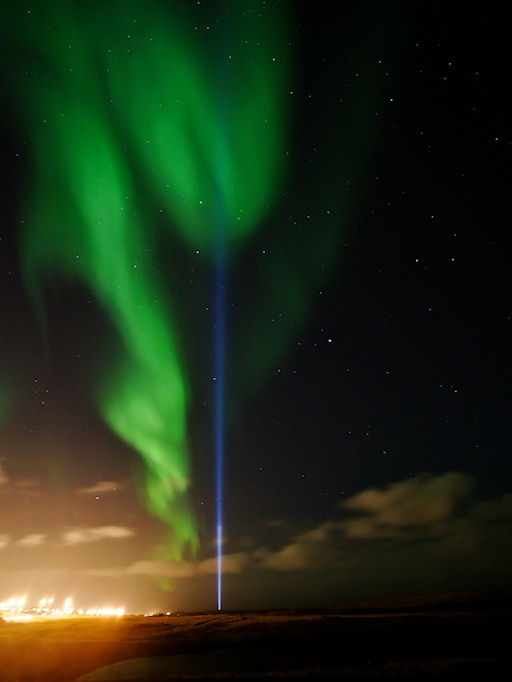iPHONE VS ANDROID! Actually, it doesn't matter which phone you carry. Our cool, new app turns both smartphones into field-tested satellite trackers. Learn more. | | |
PING! SPACE STATION RADAR ECHO: As predicted, at 8:12 pm CST on Nov. 11th, the International Space Station (ISS) flew through the US Air Force's Space Surveillance Radar beam over Texas--and it made a big ping. The echo sounds like the whistle of a speeding train. That's because the ISS is moving around Earth at 17,000 mph, and the physics of Doppler-shifts works the same in Earth-orbit as it does on Earth. The next big ping is due on Nov. 13th at 19:29:29 CST. Tune into Space Weather Radio for live echoes.
CONTRAIL COMEDY: The mystery missile of Nov. 8th--now known to be an airplane contrail--has become the butt of jokes on late-night TV and elsewhere. A comic review is available from CNN.
FRIDAY BLAST: Active sunspot 1123 erupted during the early hours of Nov. 12th, producing a C4-class solar flare and hurling a filament of material in the general direction of Earth. Click on the image to play a three and a half hour (0000 - 0330 UT) time lapse movie of the event:

Movie formats: 1.4 MB gif, 0.5 MB iPad, 0.3 MB iPhone. Credit: SDO
UPDATE: Coronagraph images from the Solar and Heliospheric Observatory (SOHO) and NASA's twin STEREO spacecraft show a faint coronal mass ejection emerging from the blast site and heading off in a direction just south of the sun-Earth line. The cloud could deliver a glancing blow to Earth's magnetic field sometime on Nov. 14th or 15th. High latitude sky watchers should be alert for auroras on those dates.
NORTHERN LIGHTS: A solar wind stream is buffeting Earth's magnetic field and stirring up auroras around the Arctic Circle. A beacon of light from the John Lennon memorial Imagine Peace Tower pointed to the display over Reykjavik, Iceland, on Nov 11th:

"The combination of the beacon and the Northern Lights resembled a beautiful flower in the sky--[a nice tribute to Lennon]," says photographer Marketa Stanczykova.
High-latitude sky watchers should remain alert for auroras as the solar wind continues to blow.
NEW! Spaceweather.com has a new sponsor, Arctic Pathfinder, a tour guide service that can take you to see the Northern Lights with your own eyes. Modes of transportation include car, snowmobile, and dog sled. Please visit their website for details.
more images: from Rob Stammes of Lofoten, Norway; from John Gray of Butt of Lewis, Outer Hebrides; from John Dean of Nome, Alaska; from Tenho Tuomi of Lucky Lake, Saskatchewan, Canada; from Larry Jenkins of Labrador City, Labrador, Canada
October 2010 Aurora Gallery
[previous Octobers: 2009, 2008, 2007, 2006, 2004, 2003, 2002, 2001]
Potentially Hazardous Asteroids (
PHAs) are space rocks larger than approximately 100m that can come closer to Earth than 0.05 AU. None of the known PHAs is on a collision course with our planet, although astronomers are finding
new ones all the time.
On November 12, 2010 there were 1164potentially hazardous asteroids.
Notes: LD means "Lunar Distance." 1 LD = 384,401 km, the distance between Earth and the Moon. 1 LD also equals 0.00256 AU. MAG is the visual magnitude of the asteroid on the date of closest approach. | | The official U.S. government space weather bureau |
| | The first place to look for information about sundogs, pillars, rainbows and related phenomena. |
| | Researchers call it a "Hubble for the sun." SDO is the most advanced solar observatory ever. |
| | 3D views of the sun from NASA's Solar and Terrestrial Relations Observatory |
| | Realtime and archival images of the Sun from SOHO. |
| | from the NOAA Space Environment Center |
| | the underlying science of space weather |

